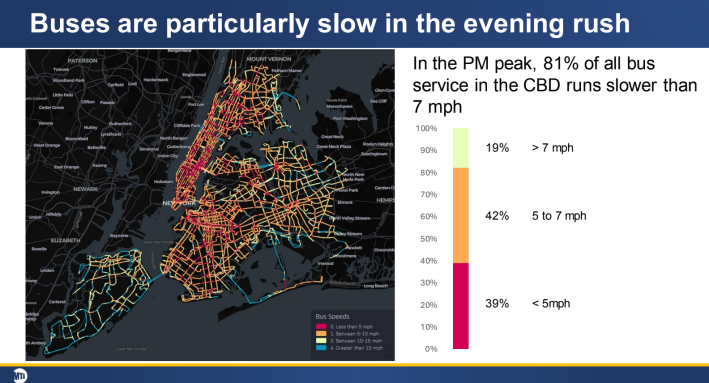The bad old days are back for the bus.
City bus speeds are back to the crawl speeds that riders experienced before the pandemic — with no relief from congestion pricing in sight thanks to Gov. Hochul.
In a presentation on Monday, MTA New York City Transit Chief of Operations Planning Chris Pangilinan shared the news of bus speeds' return to pre-pandemic levels after a couple of years of increases thanks to fewer cars and trucks on the road.
Average bus speeds, which shot up to over 9 miles per hour in 2020 during the early days of the pandemic, have sagged back down to 7.9 miles per hour as of May this year after remaining above 8 miles per hour through 2023, according to MTA figures.
That 1.1-mile-per-hour drop means hours of lost time for bus riders, Pangilinan said.
"If someone is traveling three miles on the bus, a bus that goes 7 miles per hour can get them to the destination 10 minutes faster than the bus going 5 miles per hour," he told MTA board reps.
"Every mile per hour increase in speed is quite critical for our customers, and critical for the satisfaction of our bus riders."
Bus speeds in Manhattan south of 60th Street suffered the most in the citywide slowdown. Those buses had sped up to around 7.5 miles per hour in 2020 sagged to 6 miles per hour as of May — including a ridiculously slow 5.7 miles per hour on local routes.
During the afternoon rush hour, only 19 percent of lower Manhattan buses run faster than 7 miles per hour, the MTA said.

Buses that run in Manhattan south of 60th Street were of course poised to receive the gift of sharing the streets with 17 percent fewer vehicles once congestion pricing began on June 30 this year. But Gridlock Gov. Kathy Hochul has put the program on an indefinite pause, which also leaves bus riders indefinitely stuck in traffic.
On Sunday, Hochul claimed she still has "half a dozen" ideas to clear up congested streets, without naming one.
"And for people to say that there's this effect on our climate tomorrow because we suspended this particular program – I can think of half a dozen ways we can while dealing with congestion, why people are driving in," she said on PoliticsNation with Reverend Al Sharpton.
Advocates for bus riders drew a direct line between slow bus speeds and the potential benefits of congestion pricing that Hochul's decision sacrificed.
"We know congestion pricing critics don't like the subway ... but they don't even see bus riders," Riders Alliance Director of Policy and Communications Danny Pearlstein said during public testimony during an MTA board committee meeting on Monday.
Bus speeds are also suffering outside of Manhattan — thanks in part to the failure of the city Department of Transportation under Mayor Adams to come close to meeting the 30 miles of bus lanes per year legally required under the Streets Master Plan.
Adams has dismissed the importance of painting bus lanes, telling DOT employees last year that having a legacy of faster buses was less important to him than having a legacy as a person who listened to people.
This year, the agency has presented updates on seven bus lane projects through almost the end of June — and included a handful of bus projects in its "Connecting the Core" plan meant to take advantage of the extra space for buses and bikes in Manhattan from congestion pricing.
The DOT will begin outreach on a busway for 34th Street in Manhattan in the coming months. The rest of "Connecting the Core" is still on the menu, DOT said.
"As MTA noted today, DOT’s bus lane and busway projects have shown to significantly improve travel times for riders on critical transit corridors citywide," said agency spokesperson Anna Correa.
"We are committed to continuing our Connecting to the Core planning as scheduled because we know we need to help people move more quickly into and through Manhattan’s Central Business District right now."






